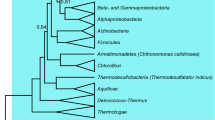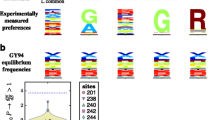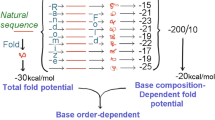Abstract
The relationship between change in genomic GC content and protein evolution in bacteria was studied by simple correlational analysis (at the genus level) and by Felsenstein's (1985) independent contrast test. We first used the dnaA gene in bacteria as an example to show (1) that the amino acid composition of a protein can be dramatically affected by mutational pressure (the genomic GC content), (2) that surprisingly, deleting relatively closely-related genera may increase rather than decrease the correlation between genomic GC content and amino acid composition, and (3) that most unexpectedly, as the genomic GC content increases, both strongly hydrophobic and strongly hydrophilic amino acids tend to change to ambivalent amino acids, suggesting that the majority of these amino acid substitutions are not caused by positive Darwinian selection. These patterns were then also shown to hold for the 14 other genes studied, indicating their generality for the evolution of bacterial proteins. As directional mutation pressure can affect the amino acid composition of proteins, it may mislead phylogenetic inference, even if protein instead of DNA sequences are used.
Similar content being viewed by others
References
Argos, P., M.G. Rossmann, U.M. Grau, A. Zuber, G. Frank & J.D. Tratschin, 1979. Thermal stability and protein structure. Biochemistry 18: 5698-5703.
Bronson, E. C. & J. N. Anderson, 1994. Nucleotide composition as a driving force in the evolution of retroviruses. J. Mol. Evol. 38: 506-532.
Cedano, J., A. Patrick, J. Perez-Pons & E. Querol, 1997. Relation between amino acid composition and cellular location of proteins. J. Mol. Biol. 266: 594-600.
Collins, D.W. & T.H. Jukes, 1993. Relationship between G+C in silent sites of codons and amino acid compositions of human proteins. J. Mol. Evol. 36: 201-203.
Dickerson, R.E. & I. Geis, 1983. Hemoglobins: Structure, Function, Evolution, and Pathology. The Benjamin/Cummings Publishing Company, Inc. Menlo Park, CA.
D'Onofrio, G., D. Mouchiroud, B. Aissani, C. Gautier & G. Bernardi, 1991. Correlations between the compositional properties of human genes, codon usage and amino acid composition of proteins. J. Mol. Evol. 32: 504-510.
Doolittle, R.F., D.-F Feng, S. Tsang, G. Cho & E. Little, 1996. Determining divergence times of the major kindoms of living organisms with a protein clock. Science 271: 470-477.
Eisen, J.A., 1995. The RecA proteins as a model molecule for molecular systematic studies of bacteria: comparison of trees of RecAs and 16S rRNAs from the same species. J. Mol. Evol. 41: 1105- 1123.
Felsenstein, J., 1985. Phylogenies and the comparative method. American Naturalist. 125: 1-15.
Fitch, W.M., 1977. Phylogenies constrained by the crossover process as illustrated by human hemoglobines and a thirteen cycle, eleven-amino-acid repeat in human apolipoprotein A1. Genetics 86: 623-644.
Harvey, P.H. & G.M. Mace, 1982. Comparisons between taxa and adpative trends: problems of methodology. Current Problems in Sociobiology (ed. King's College Sociobiology group), pp.343-361. Cambridge University Press.
Harvey, P.H. & M.D. Pagel., 1991. The Comparative Methods in Evolutionary Biology. Oxford university press.
Hasegawa, M., T. Hashimota, J. Adachi, N. Iwabe & T. Miyata, 1993. Early branchings in the evolution of eukaryotes: ancient divergence of entamoeba that lacks mitochondria revealed by protein sequence data. J. Mol. Evol. 36: 380-388.
Jukes T.H. & V. Bhushan, 1986. Silent nucleotide substitutions and G+C contents of some mitochondrial and bacterial genes. J. Mol. Evol. 24: 39-44.
Kagawa, Y., N. Nojima, N. Nukiwa, M. Ishizuka, T. Nakajima, T. Yasuhara, T. Tanaka & T. Oshima, 1984. High guanine plus cytocine content in the third letter of codons of an extreme thermophile. J. Biol. Chem. 259: 2956-2960.
Kimura, M., 1968. Evolutionary rate at the molecular level. Nature. 217: 624-626.
Kimura, M., 1983. The Neutral Theory of Molecular Evolution. Cambridge University Press, Cambridge.
King, J.L. & T.H. Jukes, 1969. Non-Darwinian evolution. Science 164: 788-798.
Kushiro, A., M. Shimizu & K. I. Tomita, 1987. Molecular cloning and sequence determination of the tuf gene coding for the elongation factor Tu of Thermus thermophilus. Eur. J. Biochem. 170: 93-98.
Lockhart, P.J., M.A. Steel, M.D. Hendy & D. Penny, 1994. Recovering evolutionary trees under a more realistic model of sequence evolution. Mol. Biol. Evol. 11: 605-612.
Moran, N.A., 1996. Accelerated evolution and Muller's rachet in endosymbiotic bacteria. Proc. Natl. Acad. Sci. USA. 93: 2873- 2878.
Muto, A. & S. Osawa, 1987. The guanine and cytosine content of genomic DNA and bacterial evolution. Proc. Natl. Acad. Sci. USA. 84: 166-169.
Nakashima, H. & K. Nishikawa, 1994. Discrimination of intracellular and extracellular proteins using amino acid compositions and residue-pair frequencies. J. Mol. Biol. 238: 54-61.
Nei, M., 1987. Molecular Evolutionary Genetics. Columbia University Press, New York.
Ohta, T., 1973. Slightly deleterious mutant substitutions in evolution. Nature 246: 96-98.
Saitou, N. & M. Nei, 1987. The neighbor-joining method: A new method for reconstructing phylogenetic trees. Mol. Biol. Evol. 4: 406-425.
Schachtel, G.A., P. Bucher, E. Mocarski, B.E. Blaisdel & S. Karlin, 1991. Evidence for selective evolution in codon usage in conserved amino acid segments of human alphaherpesvirus proteins. J. Mol. Evol. 33: 483-494.
Sogin, M.L., G. Hinkle & D.D. Leipe, 1993. Universal tree of life. Nature 362: 795.
Sueoka, N., 1961. Compositional correlation between deoxyribonucleic acid and protein. Cold Spring Harbor Symp. Quant. Biol. 26: 35-43.
Sueoka, N., 1962. On the genetic basis of variation and heterogeneity of DNA base composition. Proc. Natl. Acad. Sci. USA. 48: 582-592.
Sueoka, N., 1988. Directional mutation pressure and neutral molecular evolution. Proc. Natl. Acad. Sci. USA. 85: 2653-2657.
Woese, C.R., 1987. Bacterial evolution. Microbiol. Rev. 51: 221-271.
Zhang, Ch. & K. Chou, 1992. A correlation-coefficient method to predicting protein structural classes from amino acid compositions. Eur. J. Biochem. 207: 429-433.
Author information
Authors and Affiliations
Corresponding author
Rights and permissions
About this article
Cite this article
Gu, X., Hewett-Emmett, D. & Li, WH. Directional mutational pressure affects the amino acid composition and hydrophobicity of proteins in bacteria. Genetica 102, 383–391 (1998). https://doi.org/10.1023/A:1017028102013
Issue Date:
DOI: https://doi.org/10.1023/A:1017028102013




